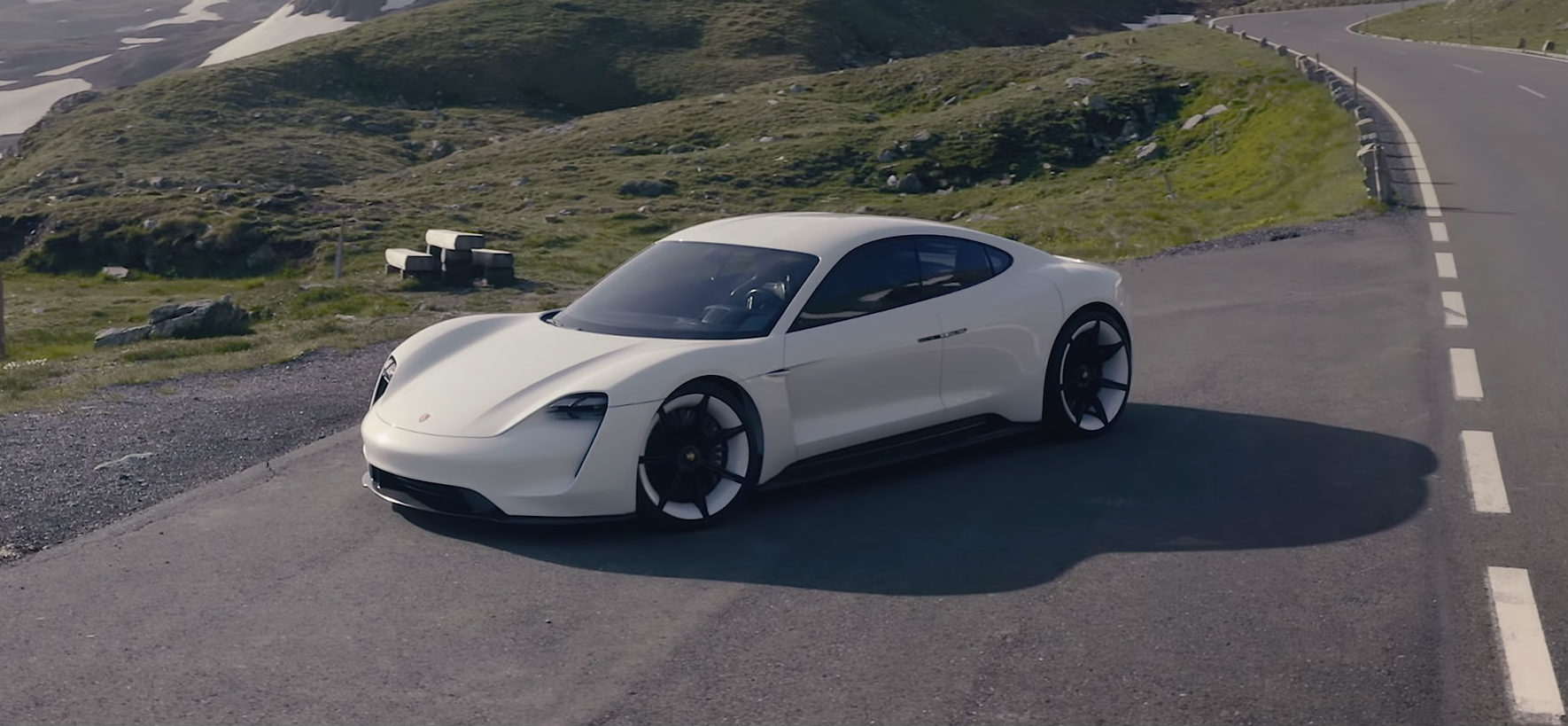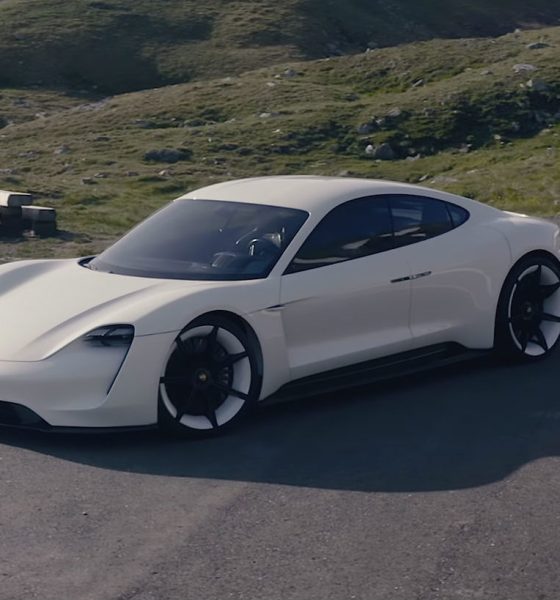

News
Porsche teases Taycan trim levels, over $130,000 price for “Turbo” variant
Porsche is expected to start the production of the Taycan, its first all-electric car, sometime in 2019. As the carmaker prepares to dip its feet into the premium EV market, some details about the upcoming vehicle are now starting to emerge. Take, for one, the names of the Taycan’s trim levels, as well as their corresponding price range.
Auto journalist Alex Roy recently shared a message he received from a Porsche Global Brand Ambassador as a response to an inquiry about the Taycan. As noted by the journalist, Porsche appears to be adopting a rather unique naming scheme for its Tesla Model S rival, particularly for the vehicle’s top trim.
Following is an excerpt from Porsche’s message to the journalist.
“I am following up on your inquiry on the upcoming Porsche Taycan. We are expecting to see the new model in about one year from now. Porsche is going to build three models — the Taycan, the Taycan 4S, and (the) Taycan Turbo. Pricing will start in the low $90,000 for the Taycan, high $90,000 for the 4S, and over $130,000 for the Turbo before options.”
Immediately noticeable is Porsche’s use of the word “Turbo” to denote the high-performance version of the Taycan. Such a naming scheme is a bit unusual for an electric car, considering that the vehicle would not have a turbo per se. That said, Roy noted in an article on The Drive that Porsche does tend to use the “Turbo” brand as a means to distinguish a halo vehicle from other cars in its lineup.
Thus, as unusual as it might be, calling the top-tier electric car the Taycan Turbo might actually be a very strategic move for the German legacy carmaker. After all, using familiar terminology on the electric car could help the company’s dedicated fanbase be more open to Porsche’s transition towards electrified mobility. Apart from this, using the “Turbo” designation for the Taycan’s top trim also gives the impression that the vehicle is a flagship car — one that the company intends to support for years to come.
Pricing-wise, the Taycan appears to be starting at a price above the entry-level Tesla Model S 75D. If the information provided by the Porsche Global Brand Ambassador proves accurate, the entry-level Taycan will start roughly $12,000 more than the entry-level Model S, which starts at $78,000. The midrange Taycan 4S, though, appears to be directly aimed at the Model S 100D, which starts at $96,000 before incentives.
Quite interestingly, the Taycan Turbo’s $130,000 starting price actually undercuts the Model S P100D’s current $135,000 starting price. That said, if the specs that Porsche announced for the vehicle — such as a 0-60 mph time of 3.5 seconds, a top speed of 155 mph, and a range of 310 miles per charge — are true for the Taycan Turbo, the vehicle would be slower off the line and have a slightly shorter range than Tesla’s flagship performance sedan. This would make the Taycan Turbo’s specs, down to its proficiency on the track, more comparable to the Model 3 Performance, which starts at a far more affordable price of $64,000.

News
Tesla FSD fleet is nearing 7 billion total miles, including 2.5 billion city miles
As can be seen on Tesla’s official FSD webpage, vehicles equipped with the system have now navigated over 6.99 billion miles.

Tesla’s Full Self-Driving (Supervised) fleet is closing in on almost 7 billion total miles driven, as per data posted by the company on its official FSD webpage.
These figures hint at the massive scale of data fueling Tesla’s rapid FSD improvements, which have been quite notable as of late.
FSD mileage milestones
As can be seen on Tesla’s official FSD webpage, vehicles equipped with the system have now navigated over 6.99 billion miles. Tesla owner and avid FSD tester Whole Mars Catalog also shared a screenshot indicating that from the nearly 7 billion miles traveled by the FSD fleet, more than 2.5 billion miles were driven inside cities.
City miles are particularly valuable for complex urban scenarios like unprotected turns, pedestrian interactions, and traffic lights. This is also the difference-maker for FSD, as only complex solutions, such as Waymo’s self-driving taxis, operate similarly on inner-city streets. And even then, incidents such as the San Francisco blackouts have proven challenging for sensor-rich vehicles like Waymos.
Tesla’s data edge
Tesla has a number of advantages in the autonomous vehicle sector, one of which is the size of its fleet and the number of vehicles training FSD on real-world roads. Tesla’s nearly 7 billion FSD miles then allow the company to roll out updates that make its vehicles behave like they are being driven by experienced drivers, even if they are operating on their own.
So notable are Tesla’s improvements to FSD that NVIDIA Director of Robotics Jim Fan, after experiencing FSD v14, noted that the system is the first AI that passes what he described as a “Physical Turing Test.”
“Despite knowing exactly how robot learning works, I still find it magical watching the steering wheel turn by itself. First it feels surreal, next it becomes routine. Then, like the smartphone, taking it away actively hurts. This is how humanity gets rewired and glued to god-like technologies,” Fan wrote in a post on X.
News
Tesla starts showing how FSD will change lives in Europe
Local officials tested the system on narrow country roads and were impressed by FSD’s smooth, human-like driving, with some calling the service a game-changer for everyday life in areas that are far from urban centers.

Tesla has launched Europe’s first public shuttle service using Full Self-Driving (Supervised) in the rural Eifelkreis Bitburg-Prüm region of Germany, demonstrating how the technology can restore independence and mobility for people who struggle with limited transport options.
Local officials tested the system on narrow country roads and were impressed by FSD’s smooth, human-like driving, with some calling the service a game-changer for everyday life in areas that are far from urban centers.
Officials see real impact on rural residents
Arzfeld Mayor Johannes Kuhl and District Administrator Andreas Kruppert personally tested the Tesla shuttle service. This allowed them to see just how well FSD navigated winding lanes and rural roads confidently. Kruppert said, “Autonomous driving sounds like science fiction to many, but we simply see here that it works totally well in rural regions too.” Kuhl, for his part, also noted that FSD “feels like a very experienced driver.”
The pilot complements the area’s “Citizen Bus” program, which provides on-demand rides for elderly residents who can no longer drive themselves. Tesla Europe shared a video of a demonstration of the service, highlighting how FSD gives people their freedom back, even in places where public transport is not as prevalent.
What the Ministry for Economic Affairs and Transport says
Rhineland-Palatinate’s Minister Daniela Schmitt supported the project, praising the collaboration that made this “first of its kind in Europe” possible. As per the ministry, the rural rollout for the service shows FSD’s potential beyond major cities, and it delivers tangible benefits like grocery runs, doctor visits, and social connections for isolated residents.
“Reliable and flexible mobility is especially vital in rural areas. With the launch of a shuttle service using self-driving vehicles (FSD supervised) by Tesla in the Eifelkreis Bitburg-Prüm, an innovative pilot project is now getting underway that complements local community bus services. It is the first project of its kind in Europe.
“The result is a real gain for rural mobility: greater accessibility, more flexibility and tangible benefits for everyday life. A strong signal for innovation, cooperation and future-oriented mobility beyond urban centers,” the ministry wrote in a LinkedIn post.
News
Tesla China quietly posts Robotaxi-related job listing
Tesla China is currently seeking a Low Voltage Electrical Engineer to work on circuit board design for the company’s autonomous vehicles.

Tesla has posted a new job listing in Shanghai explicitly tied to its Robotaxi program, fueling speculation that the company is preparing to launch its dedicated autonomous ride-hailing service in China.
As noted in the listing, Tesla China is currently seeking a Low Voltage Electrical Engineer to work on circuit board design for the company’s autonomous vehicles.
Robotaxi-specific role
The listing, which was shared on social media platform X by industry watcher @tslaming, suggested that Tesla China is looking to fill the role urgently. The job listing itself specifically mentions that the person hired for the role will be working on the Low Voltage Hardware team, which would design the circuit boards that would serve as the nervous system of the Robotaxi.
Key tasks for the role, as indicated in the job listing, include collaboration with PCB layout, firmware, mechanical, program management, and validation teams, among other responsibilities. The role is based in Shanghai.
China Robotaxi launch
China represents a massive potential market for robotaxis, with its dense urban centers and supportive policies in select cities. Tesla has limited permission to roll out FSD in the country, though despite this, its vehicles have been hailed as among the best in the market when it comes to autonomous features. So far, at least, it appears that China supports Tesla’s FSD and Robotaxi rollout.
This was hinted at in November, when Tesla brought the Cybercab to the 8th China International Import Expo (CIIE) in Shanghai, marking the first time that the autonomous two-seater was brought to the Asia-Pacific region. The vehicle, despite not having a release date in China, received a significant amount of interest among the event’s attendees.








